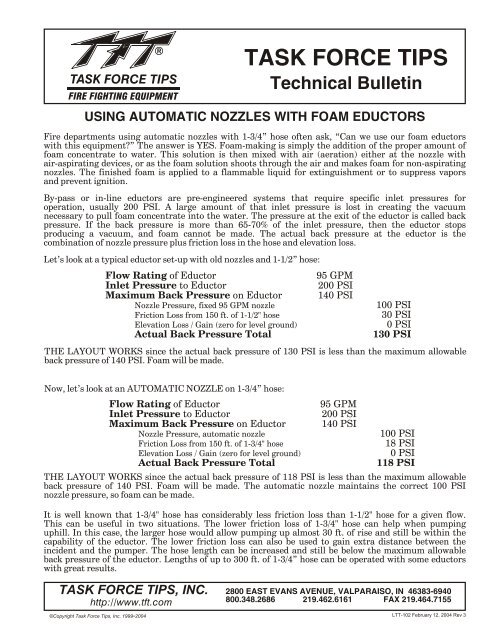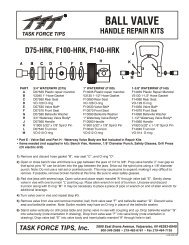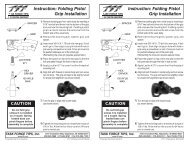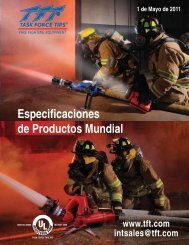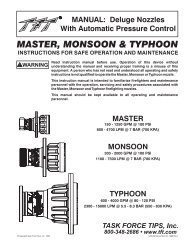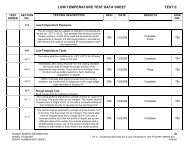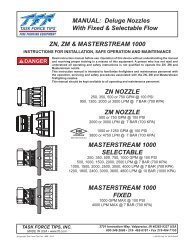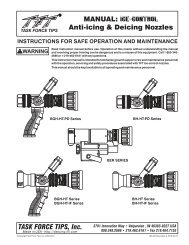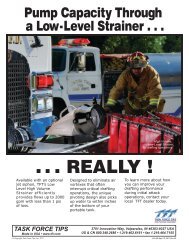Using Automatic Nozzles w/ Foam Eductors - Task Force Tips
Using Automatic Nozzles w/ Foam Eductors - Task Force Tips
Using Automatic Nozzles w/ Foam Eductors - Task Force Tips
You also want an ePaper? Increase the reach of your titles
YUMPU automatically turns print PDFs into web optimized ePapers that Google loves.
®<br />
TASK FORCE TIPS<br />
Technical Bulletin<br />
USING AUTOMATIC NOZZLES WITH FOAM EDUCTORS<br />
Fire departments using automatic nozzles with 1-3/4” hose often ask, “Can we use our foam eductors<br />
with this equipment?” The answer is YES. <strong>Foam</strong>-making is simply the addition of the proper amount of<br />
foam concentrate to water. This solution is then mixed with air (aeration) either at the nozzle with<br />
air-aspirating devices, or as the foam solution shoots through the air and makes foam for non-aspirating<br />
nozzles. The finished foam is applied to a flammable liquid for extinguishment or to suppress vapors<br />
and prevent ignition.<br />
By-pass or in-line eductors are pre-engineered systems that require specific inlet pressures for<br />
operation, usually 200 PSI. A large amount of that inlet pressure is lost in creating the vacuum<br />
necessary to pull foam concentrate into the water. The pressure at the exit of the eductor is called back<br />
pressure. If the back pressure is more than 65-70% of the inlet pressure, then the eductor stops<br />
producing a vacuum, and foam cannot be made. The actual back pressure at the eductor is the<br />
combination of nozzle pressure plus friction loss in the hose and elevation loss.<br />
Let’s look at a typical eductor set-up with old nozzles and 1-1/2” hose:<br />
Flow Rating of Eductor<br />
95 GPM<br />
Inlet Pressure to Eductor 200 PSI<br />
Maximum Back Pressure on Eductor 140 PSI<br />
Nozzle Pressure, fixed 95 GPM nozzle 100 PSI<br />
Friction Loss from 150 ft. of 1-1/2" hose 30 PSI<br />
Elevation Loss / Gain (zero for level ground)<br />
0 PSI<br />
Actual Back Pressure Total 130 PSI<br />
THE LAYOUT WORKS since the actual back pressure of 130 PSI is less than the maximum allowable<br />
back pressure of 140 PSI. <strong>Foam</strong> will be made.<br />
Now, let’s look at an AUTOMATIC NOZZLE on 1-3/4” hose:<br />
Flow Rating of Eductor<br />
95 GPM<br />
Inlet Pressure to Eductor 200 PSI<br />
Maximum Back Pressure on Eductor 140 PSI<br />
Nozzle Pressure, automatic nozzle 100 PSI<br />
Friction Loss from 150 ft. of 1-3/4" hose 18 PSI<br />
Elevation Loss / Gain (zero for level ground)<br />
0 PSI<br />
Actual Back Pressure Total 118 PSI<br />
THE LAYOUT WORKS since the actual back pressure of 118 PSI is less than the maximum allowable<br />
back pressure of 140 PSI. <strong>Foam</strong> will be made. The automatic nozzle maintains the correct 100 PSI<br />
nozzle pressure, so foam can be made.<br />
It is well known that 1-3/4" hose has considerably less friction loss than 1-1/2" hose for a given flow.<br />
This can be useful in two situations. The lower friction loss of 1-3/4" hose can help when pumping<br />
uphill. In this case, the larger hose would allow pumping up almost 30 ft. of rise and still be within the<br />
capability of the eductor. The lower friction loss can also be used to gain extra distance between the<br />
incident and the pumper. The hose length can be increased and still be below the maximum allowable<br />
back pressure of the eductor. Lengths of up to 300 ft. of 1-3/4” hose can be operated with some eductors<br />
with great results.<br />
TASK FORCE TIPS, INC.<br />
http://www.tft.com<br />
©Copyright <strong>Task</strong> <strong>Force</strong> <strong>Tips</strong>, Inc. 1999-2004<br />
2800 EAST EVANS AVENUE, VALPARAISO, IN 46383-6940<br />
800.348.2686 219.462.6161 FAX 219.464.7155<br />
LTT-102 February 12, 2004 Rev 3
Fog-type nozzles have the greatest reach in the straight stream position. The finished foam is produced<br />
as the stream projects forward, and the greatest expansion is at the end of the stream. While straight<br />
stream gives maximum reach, it can also splash flammable liquids if not carefully applied. The stream<br />
impact can be softened by deflecting the stream off nearby objects. The stream can also be trimmed to a<br />
10-15 degree pattern which gives good reach and creates a softer “snow-flaking” effect at the end of the<br />
60 GPM EDUCTOR 125 EDUCTOR<br />
Time to Empty <strong>Foam</strong> Time to Empty <strong>Foam</strong><br />
Mixture 5 Gallons flow rate Mixture 5 Gallons flow rate<br />
1% setting 8 min. 20 sec. .60 GPM 1% setting 4 min. 0 sec. 1.25 GPM<br />
3% setting 2 min. 47 sec. 1.80 GPM 3% setting 1 min. 20 sec. 3.75 GPM<br />
6% setting 1 min. 23 sec. 3.60 GPM 6% setting 40 sec. 7.50 GPM<br />
95 GPM EDUCTOR 250 GPM EDUCTOR<br />
Time to Empty <strong>Foam</strong> Time to Empty <strong>Foam</strong><br />
Mixture 5 Gallons flow rate Mixture 5 gallons low rate<br />
1% setting 5 min. 16 sec. .95 GPM 1% setting 2 min. 0 sec. 2.50 GPM<br />
3% setting 1 min. 45 sec. 2.85 GPM 3% setting 40 sec. 7.50 GPM<br />
6% setting 53 sec 5.70 GPM 6% setting 20 sec. 15.00 GPM<br />
As long as the inlet pressure to the eductor is within the manufacturer’s recommended guidelines, and<br />
the hose lay and proper nozzle combination, at the matching flow, does not exceed 65-70% of inlet<br />
pressure, foam pickup in the correct proportion will occur. The table below indicates the foam<br />
concentrate flow rate and the time it will take to empty a 5 gallon container of various concentrates<br />
with eductors of different ratings.<br />
Air-aspirating devices, such as the TFT FOAMJET, allow a wider selection of foam concentrates to be<br />
used, and can produce a better quality of finished foam. When used with AFFF, for example,<br />
air-aspirating attachments will, (1) improve the 1/4 drain time, (2) produce a more uniform bubble<br />
structure, (3) improve the burn back resistance of the finished foam, and (4) the foam blanket is visibly<br />
thicker. This thicker foam blanket has better vapor suppression and is longer lasting than foam from<br />
non-aspirated nozzles. The final expansion ratio and, therefore, the amount of finished foam, depends<br />
on the type of foam concentrate being used.<br />
It must be remembered that when using any nozzle with an eductor, the nozzle must be fully open<br />
to prevent excessive back pressure which will prevent foam pickup.<br />
Although originally designed for use with 1-1/2" hose and a nozzle of matching GPM, most eductors will<br />
function correctly with an automatic nozzle and 1-3/4" hose. By experimenting with various engine<br />
pressures on the training ground, correct operation can be assured for actual fire conditions. <strong>Automatic</strong><br />
nozzles have an excellent performance record when used as structural fire fighting nozzles. If these<br />
guidelines are followed, they will perform as well as foam-making nozzles.<br />
TASK FORCE TIPS, INC.<br />
www.tft.com<br />
©Copyright <strong>Task</strong> <strong>Force</strong> <strong>Tips</strong>, Inc. 1999-2004<br />
2800 EAST EVANS AVENUE, VALPARAISO, IN 46383-6940<br />
800.348.2686 219.462.6161 FAX 219.464.7155<br />
LTT-102 February 12, 2004 Rev 3


